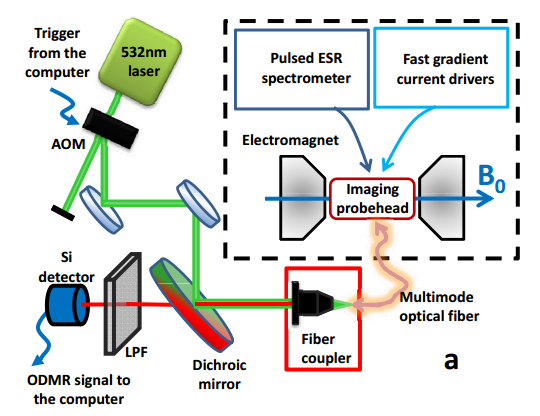First MRI Images Of Diamond Vacancies
One of the early successes in quantum computing occurred back in the early 2000s when physicists used magnetic resonance imaging to perform the first quantum computation. The idea was to control the nuclear spins in a molecule so that they interacted in a way that performed a computation.

In this way, researchers at IBM demonstrated the first examples of quantum algorithms at work.
These kinds of quantum computers have severe limits though. Because the signal from a single molecule is tiny, physicists have to use a macroscopic vial of them, a liquid containing huge numbers of molecules. This ensures that the signal is an average from all the molecules.
But it also makes it hard to control and monitor more than about seven qubits. Consequently, these computers could never be scaled up and quantum physicists have since concentrated on other techniques.
One of these involves crystals of diamond in which some carbon atoms are replaced with nitrogens. This creates a vacancy that can be exploited to store and manipulate quantum information in electron spins.
While these vacancies are easy to measure by the way they fluoresce, they are hard to address because they are so small. The way physicists do this is by placing a sharp, highly magnetised tip close to the vacancy. This creates localised magnetic field ensuring that the quantum processes of interest occur within this volume.
That has some significant disadvantages. First, these tips can only be moved across flat surfaces. So if the crystal has some kind of irregular geometry, the experiments run into trouble. A more significant problem is that it is hard to address more than one vacancy at the same time and this makes it hard to perform quantum computations.
What physicists would like is a way of controlling all of the vacancies in a diamond crystal and then reading out the results of their interactions after they have performed quantum computations.
Today, Aharon Blank and a few pals at the Technion-Israel Institute of Technology in Israel say they have done just this for the first time. Their trick is to use the standard process of magnetic resonance imaging (MRI) to address a large number of vacancies in a diamonds crystal at the same time. They then read off the results with the standard optical techniques that can see the vacancies fluoresce.
The MRI technique is essentially the same as that used by the early pioneers of quantum computing and indeed the same as that used for medical imaging. Of course, the scale is somewhat different– the diamond crystal is just a few hundred micrometres long and the vacancies themselves are atomic in size.
That is a potentially significant advance. “Such capabilities are of fundamental importance in the field of quantum spin-based devices and sensors,” say Blank and co. More specifically, this is a technique that could be an enabling technology for far more powerful quantum computers based on nitrogen vacancies in diamond.
Something to keep an eye on.
Ref: http://arxiv.org/abs/1412.8650 : Optically Detected Magnetic Resonance Imaging
Keep Reading
Most Popular
Large language models can do jaw-dropping things. But nobody knows exactly why.
And that's a problem. Figuring it out is one of the biggest scientific puzzles of our time and a crucial step towards controlling more powerful future models.
The problem with plug-in hybrids? Their drivers.
Plug-in hybrids are often sold as a transition to EVs, but new data from Europe shows we’re still underestimating the emissions they produce.
Google DeepMind’s new generative model makes Super Mario–like games from scratch
Genie learns how to control games by watching hours and hours of video. It could help train next-gen robots too.
How scientists traced a mysterious covid case back to six toilets
When wastewater surveillance turns into a hunt for a single infected individual, the ethics get tricky.
Stay connected
Get the latest updates from
MIT Technology Review
Discover special offers, top stories, upcoming events, and more.